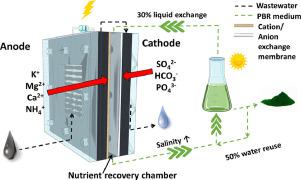Water Research ( IF 11.4 ) Pub Date : 2021-09-30 , DOI: 10.1016/j.watres.2021.117722 Zixuan Wang 1 , Christopher J Hartline 1 , Fuzhong Zhang 1 , Zhen He 1

|
Cultivating algae using wastewater nutrients is a potential approach to realize resource recovery that can contribute to circular economy. However, growing algae directly in a wastewater has problems such as bacterial contamination and a low biomass density. To address those problems, we investigated microalgal cultivation in a photobioreactor (PBR) fed with the nutrients extracted from wastewater by a microbial nutrient recovery cell (MNRC). With an external voltage of 0.3 V, the MNRC-PBR system removed 96% of COD and recovered 44% of NH4+-N and 39% of PO43−-P at a hydraulic retention time of 7.2 h. Microalgae cultivated in the nutrient recovery medium from the MNRC had 8.3-fold biomass density and 1.4-fold lipid contents, versus that cultivated in a food wastewater containing more nutrients. More significantly, 90% of biomass yielded from the MNRC-PBR system was microalgae, much higher than ∼30% in the food wastewater. A liquid exchange ratio of 30% achieved the highest microalgal density of 0.61 ± 0.06 g L−1, comparable to that in a standard BG11 medium. There was a tradeoff between recycling PBR medium and microalgal growth. The accumulated salinity was observed in the extended operation of the MNRC-PBR system treating an actual food wastewater. The results of this study have demonstrated an effective approach to extract nutrients from wastewater for enhanced microalgal growth and improved biomass quality.
中文翻译:

利用微生物电化学系统提取的废水养分强化微藻培养
使用废水养分培育藻类是实现资源回收的潜在方法,有助于循环经济。然而,直接在废水中种植藻类存在细菌污染和生物量密度低等问题。为了解决这些问题,我们研究了光生物反应器 (PBR) 中的微藻培养,该反应器使用微生物营养回收池 (MNRC) 从废水中提取的营养物质。在 0.3 V 的外部电压下,MNRC-PBR 系统去除了 96% 的 COD 并回收了 44% 的 NH 4 + -N 和 39% 的 PO 4 3−-P,水力停留时间为 7.2 小时。与在含有更多营养物质的食品废水中培养的微藻相比,在来自 MNRC 的营养回收培养基中培养的微藻具有 8.3 倍的生物量密度和 1.4 倍的脂质含量。更重要的是,MNRC-PBR 系统产生的 90% 的生物质是微藻,远高于食品废水中的 30%。30% 的液体交换率实现了 0.61 ± 0.06 g L -1的最高微藻密度,可与标准 BG11 培养基中的相媲美。在回收 PBR 培养基和微藻生长之间存在权衡。在处理实际食品废水的 MNRC-PBR 系统的扩展操作中观察到累积盐度。这项研究的结果证明了一种从废水中提取养分以促进微藻生长和改善生物质质量的有效方法。











































 京公网安备 11010802027423号
京公网安备 11010802027423号